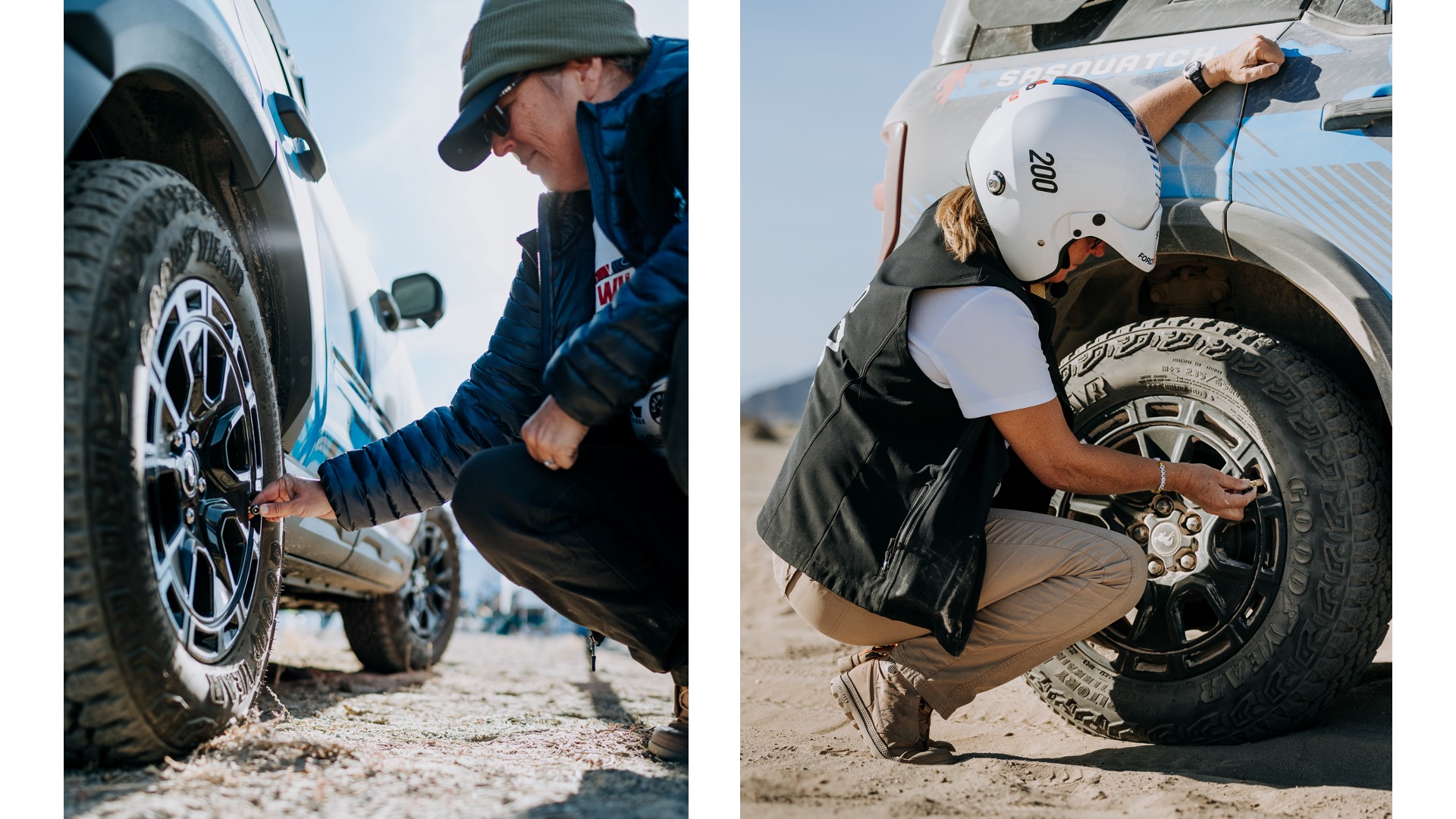Off-roading in your 2025 Ford Bronco Sport is an exciting experience, but a flat tire on the trail can quickly put a damper on your adventure, especially if you’re not prepared. Knowing how to safely change a tire in off-road conditions is essential. The 2025 Bronco Sport has some changes regarding spares compared to the earlier years that owners should be aware of, especially if you plan on taking it off the pavement.

Some 2025 Bronco Sports Are Missing a Spare Completely
Instead of even a donut style spare, many Bronco Sports are coming with what is called a Tire Sealant and Inflator Kit. According to the manual, it is used to reinflate and seal most punctures on one tire. You can then drive up to 50 mph and 120 miles to a tire shop. It further goes on to describe that the puncture must be in the tread and no larger than 6mm. The tire sealant will damage the TPMS (tire pressure monitor system) sensor and it, along with the valve stem will require replacement if the tire is deemed to be salvageable. The inflator can also be used as a regular air compressor and to confirm tire air pressure. All the directions on how to use this device is in your manual so follow instructions carefully.

No Trims Have a Full-Sized Replacement Tire
This was something I discovered and had to address before leaving on the Rebelle Rally with my Sasquatch. When I lifted the tray where the spare is stored, I discovered a different brand, and slightly smaller tire. I also realized once I replaced that spare with another Goodyear Territory, it did not “fit” in the storage area. That was fine with me because I store my spare behind the driver seat but it’s something to be aware of if you’re going to be doing any long backcountry exploring. If you invest in a Goodyear Territory as an exact replacement, you’ll have to figure out where to store it in your Sport. The same will be true if you have a flat and change it, using the “dissimilar spare” as it is called in the manual, that’s in the storage area.

Your flat tire isn’t going to fit in the same compartment where the spare is. The manual calls out to secure it in the cargo area, using a provided flat tire replacement strap.
Since I have Sports handy, I did a quick, not exactly scientific comparison against a Wildpeak on my 2021 Badlands and a Territory on my 2025 Sasquatch. Under the weight of an unloaded vehicle, the Wildpeak is just above 28”, call it 28 1/8” while the Territory on the same garage floor is right at 29”. For those of us who off-road a lot, this isn’t surprising that even though both are labeled as 235/65 R17, there is a size difference, but it does make a huge impact on where you’re going to store it.
If you do need to change your Sasquatch tire with the provided spare while off-roading, please make sure you are comfortable with ALL the indications and instructions in the manual. I’m going to cover a few of the necessary safety considerations as well as items you may want to have with you that will make changing the tire easier and safer.
Safety First: Preparing for the Tire Change
Before starting the tire change process, follow these safety precautions:
- Park on level ground if possible. Avoid hills or unstable terrain to prevent vehicle movement.
- Engage the parking brake. This prevents the vehicle from rolling.
- Chock the wheels. Place wheel chocks diagonally and across from the flat tire to stabilize the vehicle.

Choosing the Right Jack
Your Bronco Sport includes a factory jack located in the cargo area under the cargo floor. Alternatively, you can use a bottle jack or a similar tire-changing jack. However, never use a high-lift jack for changing a tire—it is designed strictly for recovery, not for lifting the vehicle for maintenance. No matter what jack you use, NEVER trust it. Jacks do fall and people have been injured or killed.
Essential Equipment
Everything you need to change a tire is stored with the spare tire. It’s also wise to carry:
- A block of wood or a wide metal base to prevent the jack from sinking into soft terrain (such as sand or mud) or to provide extra lift when needed. On my Sasquatch, the provided jack would’ve been too short in the sand, so I always have blocks to distribute the weight as well as give the jack a little more height.
- A lug wrench or an impact wrench to remove and tighten the lug nuts.
- Extra lug nuts as you never know when one will cross thread or even go missing. I keep them where I store my tire changing tools.
- A torque wrench to confirm the lug nuts are tight enough and not overtightened. This might not be essential but it is nice. If you don’t have one, make sure you regularly check the lug nuts for tightness until you get to a tire shop. Even if you do use one, checking for tightness after a few miles is important.
Steps to Changing the Tire
- Locate the Jacking Points
- The correct jacking points are on the frame of the vehicle. Never place the jack in an unsupported location, as this can cause damage to the vehicle.

- Place the Spare Tire Under the Car, Near the Jacking Point
- This is a practice I use as an added safety measure if the jack falls while raising it and when removing the tire.
- Loosen the Lug Nuts
- Before lifting the vehicle, slightly loosen the lug nuts using the lug wrench. This prevents the wheel from spinning when raised.
- Position the Jack and Lift the Vehicle
- Place the jack on a firm, level surface. Use a wooden block or metal base under the jack if necessary.
- Slowly raise the vehicle until the flat tire is off the ground.
- Remove the Flat Tire and Install the Spare
- Fully unscrew the loosened lug nuts and remove the flat tire.
- Align the spare tire with the wheel hub and hand-tighten the lug nuts.
- Lower the Vehicle and Tighten the Lug Nuts
- Slowly lower the vehicle until the tire just touches the ground.
- Tighten the lug nuts in a crisscross pattern to ensure even pressure.
- Secure the Flat Tire
- Place the flat tire in the cargo area and secure it to prevent movement or damage to the interior.

Final Checks
- Double-check that all lug nuts are properly tightened.
- Ensure all tools and the jack are properly stored.
- Inspect the spare tire’s pressure and adjust if necessary.
Being prepared for a flat tire while off-roading is essential for safety and convenience. If you’ve purchased a 2025 Bronco Sport and it only includes a tire sealant kit, I would highly recommend upgrading to a full-sized spare, especially if you plan on off-roading. There's also huge value in having a tire plug kit and knowing how to use it.
Having a plan before you head out on your adventure can make all the difference. Since flats happen and are fairly common, make sure you address this before you leave home.

Comments
You must log in or register to post here.